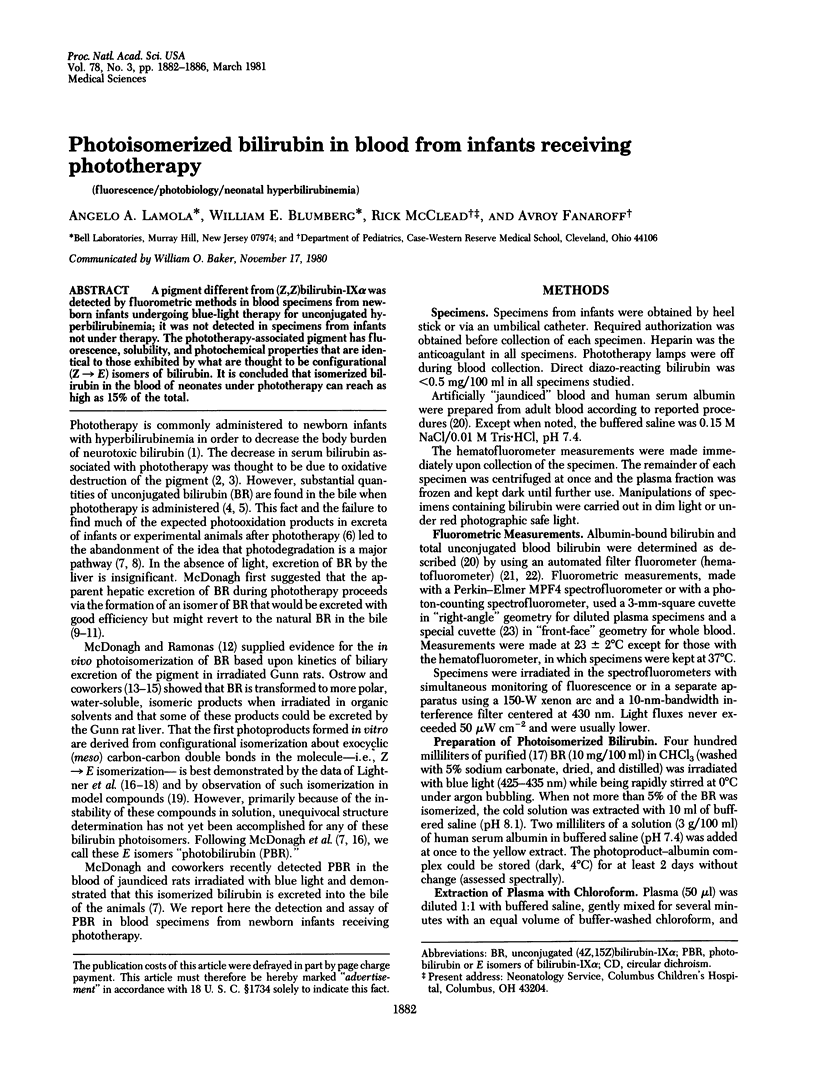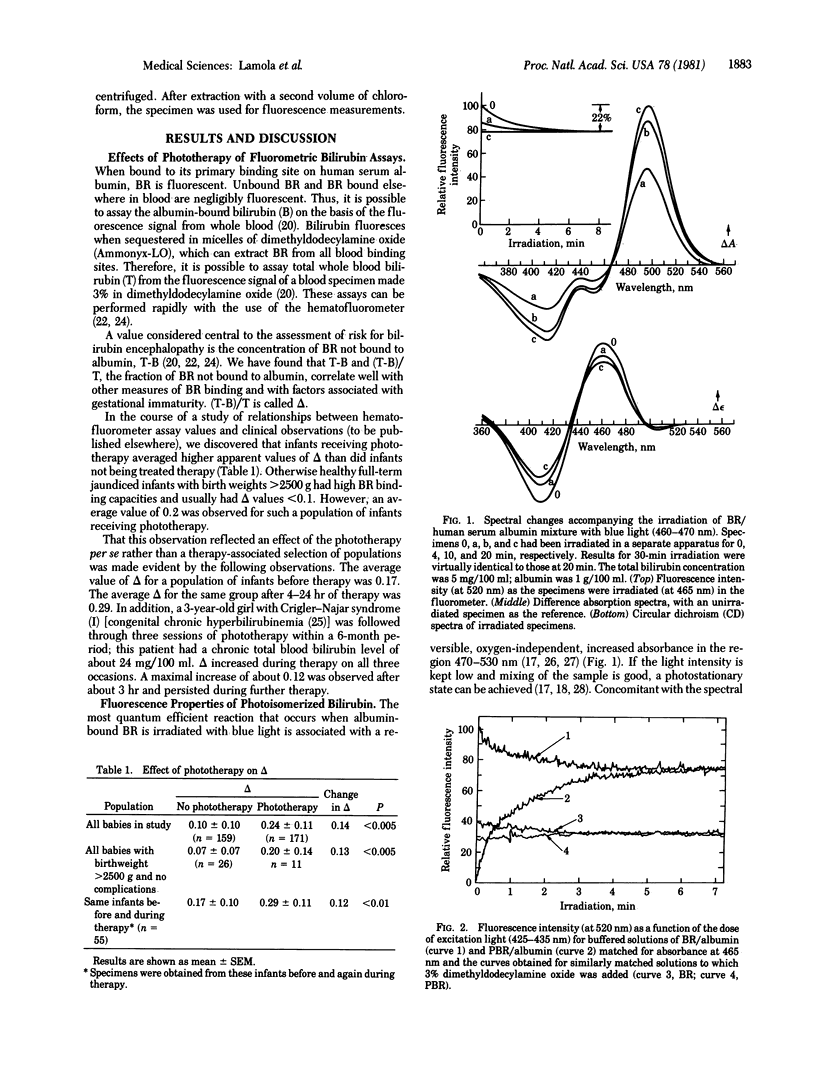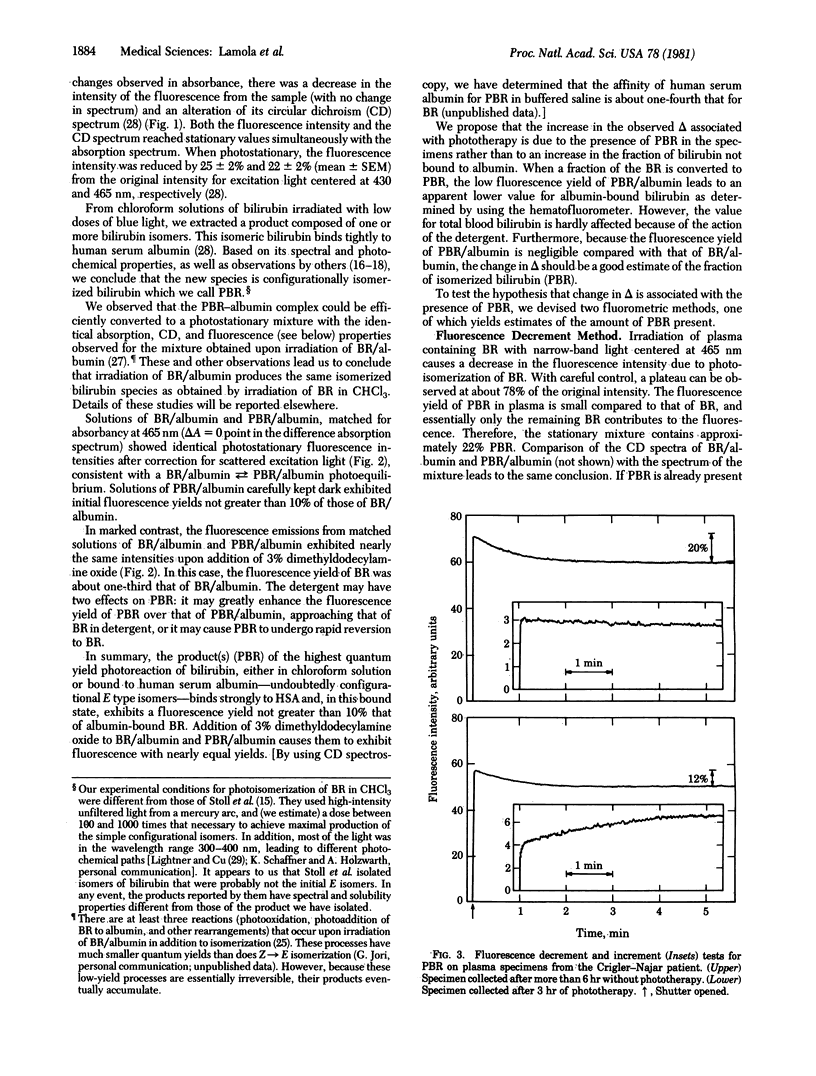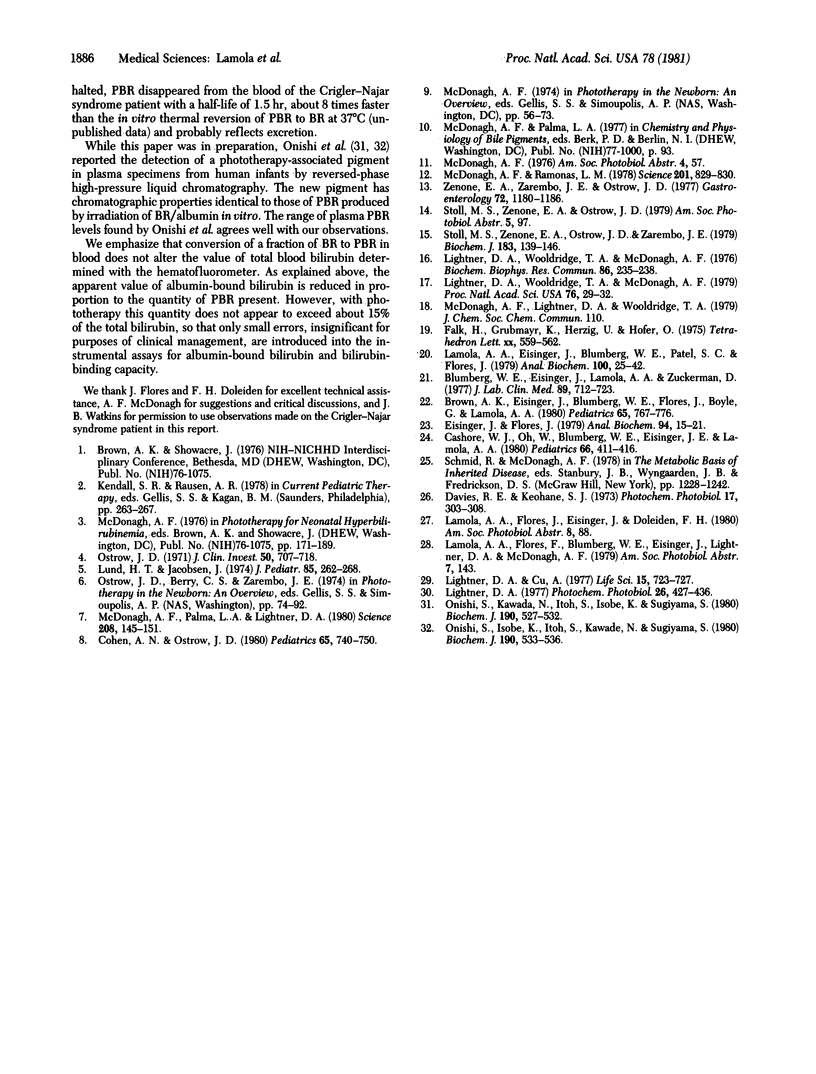Abstract
A pigment different from (Z,Z)bilirubin-IX alpha was detected by fluorometric methods in blood specimens from newborn infants undergoing blue-light therapy for unconjugated hyperbilirubinemia; it was not detected in specimens from infants not under therapy. The phototherapy-associated pigment has fluorescence, solubility, and photochemical properties that are identical to those exhibited by what are thought to be configurational (Z leads to E) isomers of bilirubin. It is concluded that isomerized bilirubin in the blood of neonates under phototherapy can reach as high as 15% of the total.
Full text
PDF




Selected References
These references are in PubMed. This may not be the complete list of references from this article.
- Blumberg W. E., Eisinger J., Lamola A. A., Zuckerman D. M. Zinc protoporphyrin level in blood determined by a portable hematofluorometer: a screening device for lead poisoning. J Lab Clin Med. 1977 Apr;89(4):712–723. [PubMed] [Google Scholar]
- Brown A. K., Eisinger J., Blumberg W. E., Flores J., Boyle G., Lamola A. A. A rapid fluorometric method for determining bilirubin levels and binding in the blood of neonates: comparisons with a diazo method and with 2-(4'-hydroxybenzene)azobenzoic acid dye binding. Pediatrics. 1980 Apr;65(4):767–776. [PubMed] [Google Scholar]
- Cashore W. J., Oh W., Blumberg W. E., Eisinger J., Lamola A. A. Rapid fluorometric assay of bilirubin and bilirubin binding capacity in blood of jaundiced neonates: comparisons with other methods. Pediatrics. 1980 Sep;66(3):411–416. [PubMed] [Google Scholar]
- Cohen A. N., Ostrow J. D. New concepts in phototherapy: photoisomerization of bilirubin IX alpha and potential toxic effects of light. Pediatrics. 1980 Apr;65(4):740–750. [PubMed] [Google Scholar]
- Davies R. E., Keohane S. J. Early changes in light-irradiated solutions of bilirubin: a spectrophotometric analysis. Photochem Photobiol. 1973 May;17(5):303–312. doi: 10.1111/j.1751-1097.1973.tb06358.x. [DOI] [PubMed] [Google Scholar]
- Eisinger J., Flores J. Front-face fluorometry of liquid samples. Anal Biochem. 1979 Apr 1;94(1):15–21. doi: 10.1016/0003-2697(79)90783-8. [DOI] [PubMed] [Google Scholar]
- Lamola A. A., Eisinger J., Blumberg W. E., Patel S. C., Flores J. Flurorometric study of the partition of bilirubin among blood components: basis for rapid microassays of bilirubin and bilirubin binding capacity in whole blood. Anal Biochem. 1979 Nov 15;100(1):25–42. doi: 10.1016/0003-2697(79)90105-2. [DOI] [PubMed] [Google Scholar]
- Lightner D. A., Cu A. Wavelength dependence of bilirubin photoreactivity. Life Sci. 1977 Feb 15;20(4):723–731. doi: 10.1016/0024-3205(77)90478-7. [DOI] [PubMed] [Google Scholar]
- Lightner D. A., Wooldridge T. A., McDonagh A. F. Configurational isomerization of bilirubin and the mechanism of jaundice phototherapy. Biochem Biophys Res Commun. 1979 Jan 30;86(2):235–243. doi: 10.1016/0006-291x(79)90857-x. [DOI] [PubMed] [Google Scholar]
- Lightner D. A., Wooldridge T. A., McDonagh A. F. Photobilirubin: an early bilirubin photoproduct detected by absorbance difference spectroscopy. Proc Natl Acad Sci U S A. 1979 Jan;76(1):29–32. doi: 10.1073/pnas.76.1.29. [DOI] [PMC free article] [PubMed] [Google Scholar]
- Lund H. T., Jacobsen J. Influence of phototherapy on the biliary bilirubin excretion pattern in newborn infants with hyperbilirubinemia. J Pediatr. 1974 Aug;85(2):262–267. doi: 10.1016/s0022-3476(74)80408-7. [DOI] [PubMed] [Google Scholar]
- McDonagh A. F., Palma L. A., Lightner D. A. Blue light and bilirubin excretion. Science. 1980 Apr 11;208(4440):145–151. doi: 10.1126/science.7361112. [DOI] [PubMed] [Google Scholar]
- McDonagh A. F., Ramonas L. M. Jaundice phototherapy: micro flow-cell photometry reveals rapid biliary response of Gunn rats to light. Science. 1978 Sep 1;201(4358):829–831. doi: 10.1126/science.581101. [DOI] [PubMed] [Google Scholar]
- Onishi S., Isobe K., Itoh S., Kawade N., Sugiyama S. Demonstration of a geometric isomer of bilirubin-IX alpha in the serum of a hyperbilirubinaemic newborn infant and the mechanism of jaundice phototherapy. Biochem J. 1980 Sep 15;190(3):533–536. doi: 10.1042/bj1900533. [DOI] [PMC free article] [PubMed] [Google Scholar]
- Onishi S., Kawade N., Itoh S., Isobe K., Sugiyama S. High-pressure liquid chromatographic analysis of anaerobic photoproducts of bilirubin-IX alpha in vitro and its comparison with photoproducts in vivo. Biochem J. 1980 Sep 15;190(3):527–532. doi: 10.1042/bj1900527. [DOI] [PMC free article] [PubMed] [Google Scholar]
- Ostrow J. D. Hemoccult testing. Gastroenterology. 1977 Nov;73(5):1185–1186. [PubMed] [Google Scholar]
- Ostrow J. D. Photocatabolism of labeled bilirubin in the congenitally jaundiced (Gunn) rat. J Clin Invest. 1971 Mar;50(3):707–718. doi: 10.1172/JCI106541. [DOI] [PMC free article] [PubMed] [Google Scholar]
- Stoll M. S., Zenone E. A., Ostrow J. D., Zarembo J. E. Preparation and properties of bilirubin photoisomers. Biochem J. 1979 Oct 1;183(1):139–146. doi: 10.1042/bj1830139. [DOI] [PMC free article] [PubMed] [Google Scholar]


